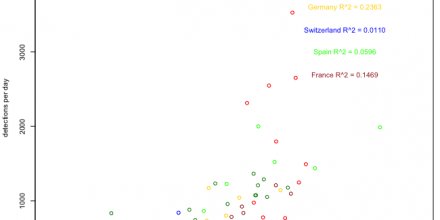history+ offers historical weather simulation data for the selected location(s) across the whole world, with a spatial resolution between 4 and 30 km. These hourly data reach back to 1979, are 100% complete, with more than 50 variables and are available for any place on Earth and on different altitude levels, independent of weather measurement stations. Simulation data are especially suitable for assessing weather over longer time periods, compare years, seasons and even locations and track effects like climate change. Interactive graphs allow immediate access to continuous time series, yearly comparisons, immediate summaries and new insights for your location(s).
Starting in 1979, the historical weather data are available in hourly steps or daily aggregations with a spatial resolution of 30 km, whereas higher resolution data are available since 2008 for nearly every place on Earth. You can choose between model data from ERA5 and NEMS30 model data. Extensive verifications of our weather models ensure top data accuracy.
You can get your own history+ access with 50% discount using the coupon code
history20200409prom
You can enter this code AFTER selecting the desired number of locations and clicking "Buy", then you will get a 50% discount on the regular purchase price and access to the data for the selected locations during an entire year.
During the Easter days, we will also (within a day) be answering your questions.
Snow days...
The meteoblue team went on snow patrol in the Alps and we found the expected: snow, sun, and a great day. We left a few traces and hope that our viewers will enjoy them.
After meticulous contingency planning, daily forecast watching and last minute adjustments (thanks to all for their flexibility), we were able to enjoy a day in the (well predicted) fresh snow with hikes, skiing, gorgeous mountain views, snow sculptures and what else you do in the snow, so the journey lasted late into the night - but we've recovered since.


history+ with ERA5
history+ now reaches 40 years backwards, with the ERA-5 hourly meteorological data from 1979 to end 2019. Unique in precision and data range of >50 weather variables makes history+ the broadest and most accessible historic weather offer currently available - for the same price as before!
history+ gets a major upgrade with a full hourly ERA5 reanalysis dataset and a unique range of variables >50 major weather variables including evapotranspiration, soil temperature, soil moisture and plant available moisture [from 0 to 255 cm deep], total column cloud water and many others. ERA5 has been calculated by the ECMWF from 1979 to 2019, based on historic weather simulations and measurements, producing the highest precision hourly historic dataset globally available, which is updated regularly within 3 months of real time. This makes history+ the broadest and most comprehensive historic weather offer currently available - for the same price as before.
history+ allows you to create unique historic weather time series, do climate analysis, analyse the effect of weather on your operations and even check the (absence of) impact on Corona-Virus, and thereby uncovering unique (cor)relations.
Does weather influence Corona Virus?
To contribute to the Coronavirus (COVID-19) risk assessment, meteoblue provides the first global study on relationship between Corona-Virus infections and weather conditions.
We selected 21 countries from 5 continents and all global climate zones, with a total of 103'814 cases of diagnosed Coronavirus (COVID-19) detection (infections), and analysed the correlation of new infections with 6 major weather variables (air temperature , relative humidity, radiation, wind speed, sunshine hours and precipitation) during the period from 01.January to 18.March 2020, using our hourly history+ data, which can be readily downloaded for any place on Earth.
The study produced no visible correlations for any of the variables, neither in 21 countries from 5 continents and all global climate zones, nor within the 7 countries with most detections in March (China, Italy, Spain, France, Germany, Switzerland, Iran).
Although this study is preliminary, some important conclusions seem possible:
- Higher air temperatures are unlikely to slow the spread of the virus significantly.
- The COVID-19 infections seem to be largely independent of external weather influence.
- Further analysis should focus on the effect of temperature, relative humidity and radiation, by reducing masking factors such as behaviours changes (public restrictions, hygiene measures, others), location differences and reporting imprecision.
As a general summary, we conclude that containment of COVID-19 infections can not rely on weather as a significant factor in helping reduce the spread of the disease. The detailed study is available for download here.
We will continue investigations into more detailed relations, and appreciate any contributions and suggestions.
Greetings from Home Office
We are grateful to say, that we are required and able to work from home. Weather continues to be important for many operations and we the meteoblue staff are supporting them with our entire work-force, including some new “colleagues”.
All of us have to adapt our way of working and living to limit the spread of COVID-19, and we as meteoblue want to make our contribution too. Moving all operations to distributed home office has been a special challenge, which our staff have mastered brilliantly: all systems are functional, all of us connected, and all our customer enquiries and our meetings virtual - including the "coffee breaks". Some of us are discovering new opportunities: faster programming in the peace of home, exercise in the sun, and new “colleagues” like hamster "Midge".
Even if the normal life is almost at standstill, we are still there for you with our usual weather services and our user and customer support, and the engagement to produce new insights.
Are you also working at home? Share your work environments with us by tagging meteoblue on social media!
Facebook
Twitter
Instagram









